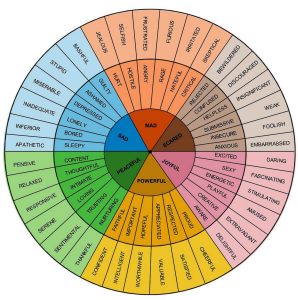4 Simple Steps To Improve Your Self-Talk To Reduce Anxiety and Depression

4 Simple Steps To Improve Your Self-Talk To Reduce Anxiety and Depression
There are some common things that I hear from clients in the therapy room that tend to contribute to the perpetuation of anxiety and depression, and I want to provide a little relief to those of you who struggle with anxiety or depressive symptoms, whether you are in therapy or not. Language is very important as a means of interpersonal communication, but people often underestimate the degree to which the way we talk to ourselves (self-talk) impacts our mental and emotional states. When we are struggling with depression or anxiety, it is crucial that we stay attuned to our self-talk. Every moment is an opportunity that we can either use to judge ourselves, or to increase self-compassion, which will ultimately lead to more long-term life satisfaction.
Here are some simple steps to improve your self-talk:
Notice your use of “should,” “must,” “need to,” and “have to.”
We all have obligations. However, when you impose an obligation on an emotional state, it has an emotional consequence in and of itself. For example, I’ve had many clients tell me that they “should” not feel sad because they have such good things going on in their lives. They believe that if they are fortunate, they don’t have the right to complain. The result of this self-statement is for the client to feel frustrated with themselves. Frustration with oneself is often equivalent to feeling ashamed or guilty. Guilty feelings is one common symptom of depression. Therefore, utilizing these words (should, must, need to, have to) in your self-talk makes you prone to experiencing guilt and/or shame, which can contribute to an increase in depression.
Emotions are emotions. Thoughts are thoughts.
People commonly say, “I feel…” and then insert a thought afterwards, as in “I feel that nobody cares about me.” You may not realize it, but this is a thought and not a feeling. Sadness is a feeling. Loneliness is a feeling. Someone not caring about me is a thought or a perception. When we turn thoughts into emotions, it’s harder to challenge them. For example, if you tell someone you feel sad, they can’t come back to you and say, “you don’t feel sad” and be correct. It’s a subjective experience and if it’s true for you, it’s true. Dysfunctional thoughts, on the other hand, such as “nobody cares about me,” can be challenged. Is it really true that nobody cares about you? Probably not. Would it make sense to challenge the thought and be open to the possibility that there may be some people that do care about you? Absolutely!
Therefore, I suggest that you end a statement that starts with “I feel” with an “emotion word.” Anything other than an emotion word in that position is a thought, which you can challenge (ask yourself whether that thought is true or how much you believe that thought.) In my experience, being able to name an actual emotion is very powerful in helping people to regulate their emotions. Daniel J. Siegel M.D. posits that when we are able to identify emotions, it assists us in integrating the right and left hemispheres of our brains. One of the tools I like to use for those who may have an underdeveloped emotional vocabulary is a feeling wheel. I have included an example below. By expressing thoughts as thoughts and emotions as emotions, you can start to acknowledge and accept your emotions and challenge unhealthy thoughts, which can certainly lead to less anxiety and depression.
Emotions are not negative or bad; however, some can be difficult.
Most people fall into the trap of labeling emotions as good or bad. How many times have you said “I’m sorry. I feel so bad that I did that!” when you really mean that you feel guilty? It’s easy to categorize emotions in that way. The “pursuit of happiness” in everyday life has become a misguided goal of Western culture. Happiness equals good and sadness, anger and fear are bad or negative. Even the Dalai Lama talks about refraining from negative thoughts and emotions. If everyone feels certain emotions and are told that those emotions are bad, we begin to feel guilty or ashamed for feeling them. How often have you seen someone cry who then apologizes for their tears?
As you can see from the feeling wheel above, about half of our emotional experience can be labeled as bad or negative, so it would be unlikely that we would experience pleasant emotions 100% of the time. Some of the emotions above on the feeling wheel are difficult to experience, for sure, but labeling those as bad or negative reinforces pressure and expectation to feel “good”. Therefore, I encourage you to change your vocabulary and self-talk about emotions. When labeling emotions such as sadness, anger, fear, guilt and shame, I prefer to use words like difficult or painful, rather than bad or negative. This change will help you more accurately describe your emotional experience, which often leads to relief.
Use “and,” not “but.”
You may have heard before that when you use “but” after an apology it negates the apology. For example, “I’m sorry, but I just didn’t understand your directions.” In this case, it does not seem like a sincere apology, and rather seems like I am blaming you for my making a mistake. Using “but” in your own self-talk can also have a significant impact on your self-perception and emotional state. Imagine that you are trying to make some kind of change in your life and you worry that you will fail. If you say “I really would like to make this change, but I’m scared,” it’s different than saying “I really would like to make this change, and I’m scared.” If you use the former, you are more likely to allow your emotion to dictate your behavior (and not make the change) whereas the latter statement conveys more conflict between the desire and the emotion, which may more accurately reflect your personal reality, and in the long-term allow you to make an intentional choice about your next action (make a positive change).
If you often feel overwhelmed and you think that changing your self-talk might benefit you, the first step is to notice it. Take one or two days, and notice how often you 1) tell yourself you “shouldn’t” feel anxious, angry or sad, 2) say thoughts in place of feelings, 3) label your feelings as “bad” or “negative” and 4) use “but” instead of “and.” Once you notice your tendencies, you may observe that you judge yourself about doing these things. Notice this as well. Once you have observed what is going on in your mind, you can begin to increase self-compassion and reduce depression and anxiety by bringing in a kinder, gentler voice to support yourself when you are experiencing something challenging or not performing at your best.
Thanks for reading.
If you would like further support or guidance, and you are in the Nashville area, please do not hesitate to contact us at (615) 582-2882 or email me at clientcare@nashvillepsych.com to schedule an appointment for individual therapy.
Take good care,
Dan


